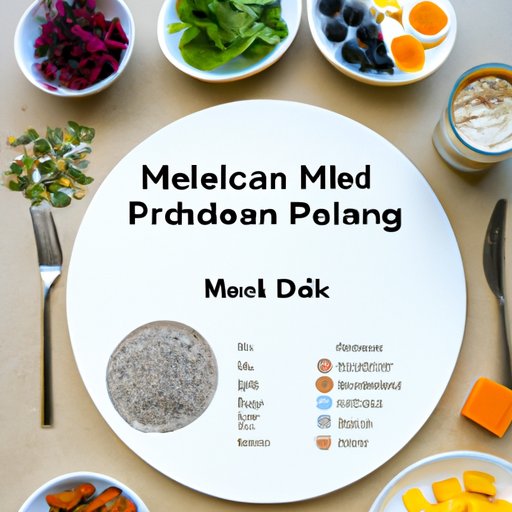Introduction
Eating healthy is an important part of living a healthy lifestyle. A healthy diet can help reduce the risk of chronic diseases, maintain a healthy weight, and provide the body with the essential nutrients it needs to function properly. But what exactly does it mean to eat healthy?
According to the World Health Organization (WHO), “a healthy diet is one that helps to maintain or improve overall health. A healthy diet provides the body with essential nutrition: fluid, macronutrients, micronutrients, and adequate calories.” In other words, eating healthy means consuming a variety of nutritious foods that provide the body with the vitamins, minerals, and energy it needs to stay healthy.
Research-Based Tips for Healthy Eating
Understanding the basics of healthy eating is the first step to making better food choices. Here are some research-based tips to help you make smart decisions about what to eat:
Understanding Macronutrients and Micronutrients in Foods
Macronutrients are the nutrients that provide the body with energy. They include carbohydrates, fats, and proteins. Micronutrients, on the other hand, are the nutrients that help the body function properly. They include vitamins, minerals, and antioxidants.
It’s important to get enough of both macronutrients and micronutrients in your diet. Eating a variety of nutrient-dense foods can help ensure that you’re getting all the essential nutrients your body needs.
Choosing Nutrient-Dense Foods
Nutrient-dense foods are foods that are packed with essential vitamins, minerals, and other nutrients. Examples of nutrient-dense foods include fruits, vegetables, whole grains, lean proteins, low-fat dairy products, and healthy fats. Eating these foods can help you meet your daily nutritional needs while also providing your body with the energy it needs.
Smart Strategies for Eating on the Go
For those who are always on the go, it can be difficult to make healthy food choices. But there are some simple strategies you can use to make sure you’re getting the nutrition you need. For example, packing snacks like nuts, seeds, and fruits can help you avoid unhealthy convenience foods. You can also look for restaurants that offer healthier options, such as salads and grilled proteins.
Exploring Different Diets for Optimal Health
When it comes to eating healthy, there are many different approaches. Here are some of the most popular diets for promoting optimal health:
Paleo Diet
The Paleo diet is based on the idea of eating like our ancestors did. It focuses on unprocessed, whole foods like meats, fish, eggs, vegetables, fruits, nuts, and seeds. Proponents of this diet believe that it can help reduce inflammation, improve digestion, and promote weight loss.
Vegan Diet
A vegan diet focuses on plant-based foods, such as fruits, vegetables, legumes, nuts, and seeds. This diet eliminates all animal-based products, including meat, eggs, and dairy. Studies have shown that following a vegan diet can help reduce the risk of chronic diseases, promote weight loss, and improve overall health.
Mediterranean Diet
The Mediterranean diet is based on the traditional cuisine of countries bordering the Mediterranean Sea. It emphasizes the consumption of fresh fruits and vegetables, whole grains, legumes, nuts, and olive oil. Studies have found that this diet can help reduce the risk of heart disease, lower cholesterol levels, and improve overall health.

Creating a Meal Plan for Balanced Nutrition
Creating a meal plan can help you make sure you’re getting all the essential nutrients your body needs. Here are some tips for creating a balanced meal plan:
Establishing Calorie Intake Goals
The first step to creating a balanced meal plan is to determine your calorie intake goals. To do this, you’ll need to calculate your basal metabolic rate (BMR). Your BMR is the number of calories your body needs to maintain its current weight. Once you know your BMR, you can then adjust your calorie intake goals accordingly.
Balancing Macronutrients
Once you’ve established your calorie intake goals, you can begin to balance your macronutrients. Aim to get 45-65% of your total calories from carbohydrates, 10-35% from protein, and 20-35% from fat. This will help ensure that you’re getting all the essential macronutrients your body needs.
Incorporating Superfoods
Superfoods are nutrient-dense foods that are packed with essential vitamins, minerals, and antioxidants. Incorporating superfoods into your diet can help you meet your daily nutritional needs. Some examples of superfoods include salmon, blueberries, kale, quinoa, and avocados.
Conclusion
Eating healthy is an important part of living a healthy lifestyle. Understanding macronutrients and micronutrients in foods, choosing nutrient-dense foods, exploring different diets for optimal health, and creating a meal plan for balanced nutrition are key to achieving optimal health. By incorporating these tips into your lifestyle, you can reap the many benefits of healthy eating.
(Note: Is this article not meeting your expectations? Do you have knowledge or insights to share? Unlock new opportunities and expand your reach by joining our authors team. Click Registration to join us and share your expertise with our readers.)
